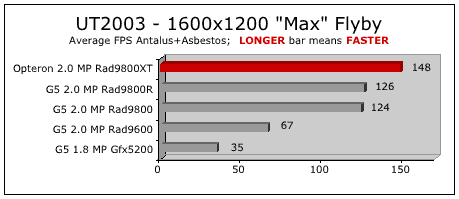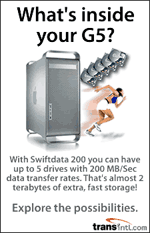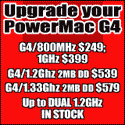SPEED TEST RESULTS complete listing by Category
|
3D Graphics |
|
|
Posted
12/15/03 by Rob-ART,
mad scientist This is a continuation of PAGE ONE where ran CPU intensive tests. On this page we will stress the 3D graphics subsystem.
We originally pulled the hi-rez graphs of 3D stress tests from this page because we found out that the Opteron was sporting a Radeon 9800 Pro XT (412MHz core clock speed), not just a Radeon 9800 Pro (380MHz core clock). The G5 was at a double disadvantage with the OEM Radeon 9800 Pro with less memory (256MB vs 128MB) and with slower core clock speed (350MHz). We found a Radeon 9800 Pro for the Opteron and tried to retest, but it kept giving us device failures and switching to software render mode or causing the screen to go black or applications to crash. After trying different drivers, Xicomputer concluded that the Tyan motherboard used by the Opteron doesn't "like" Radeon boards. After over a month of fiddling, I've decided to restore the original graphs with one addition: I've included test results for the G5 running a Retail Radeon 9800 Pro which has a faster core clock speed than the OEM version (380 vs 350MHz). However, it has a 4X AGP rating instead of 8X. (Can't win.) ATI has announced a 256MB Special Edition of the Radeon 9800 Pro for the Mac. We'll include results from it as soon as we get our hands on that card. Meanwhile, I'll trust the results will be instructive, if not fair. And objective minds will agree that the gap between the Opteron and G5 is probably closer than most of these graphs would indicate.
The Botmatch is not only CPU intensive, but the PC version runs in Direct X mode while the Mac versions runs in OpenGL mode (spelled "not as efficient"). Some say this isn't a fair comparison, but if you are choosing between the two platforms, you need to know how UT2003 runs Botmatches on the one you choose.  The gap closes here as the graphics card becomes the bottleneck. The G5 with the 9800 Pro does well, considering it has half the video memory (128MB vs 256MB) and a slower core clock speed (350/380 vs 412MHz).
Again, the gap is not as big as it appears, considering the difference in graphics cards. ANALYSIS OF 3D Stress Tests Taking in consideration the different specs on the graphics cards, I would say that the Opteron and G5 are very close in speed when running 3D applications in modes that lean hard on the 3D graphics card. The Opteron displayed a clear advantage when running the UT2003 Botmatch -- a function that's CPU intensive. The fact that more games are first and only on Windows PCs gives the Opteron (and any fast Windows PC) the nod as "the better game machine." We hope to add Halo results to the graphs above in the near future.
Go BACK to
PAGE
ONE
for CPU
Crunch tests, Or return to MAIN INDEX Has Bare Feats helped you? |
Ê
Ê
Ê
![]()
Refurbished Macs? Think Small. Think SmallDog.com
Order the Bose QuietComfort 2 Headphones through Sharper Image and Bare Feats gets a 10% commission.
"BARE facts on Macintosh speed FEATS"
Email webmaster at rob-art@barefeats.com










